This trip was taken in February of 2019.
Pyongyang is the political and cultural centre of the Democratic People’s Republic of Korea (DPRK) and by far the biggest city in the country with a population of over 3 million.
During the Korean War, Pyongyang became the target of the biggest aerial attack of the conflict, destroying large parts of the city.
This, however, gave the communist leadership the opportunity to envision a masterplan for the reconstruction of today’s capital, pairing the garish Stalinist architectonical style with traditional Korean elements.
Thus, most major landmarks are located in the city centre in close proximity to each other, making it relatively easy to see most of them in a day or two.
This list represents the itinerary of my time in Pyongyang, tightly packed into a single day.
KIM IL-SUNG SQUARE
Kim Il-sung Square is probably the most iconic landmark in Pyongyang.
Playing host to huge military parades, rallies, mass dances and other festivities, it is located right next to the Taedong-gang River in the heart of the North Korean capital and the place most shown in Western media.
Vis-à-vis the river sits the Great People’s Study Hall. Two huge portraits of Kim Il-sung and his son Kim Jong-il hang on its front, which is quite a common sight in the DPRK.
The square is flanked by the Ministry of External Economic Relations in the south and the headquarters of the Worker’s Party of Korea (WPK) in the north.
The Ministry of External Economic Relations shows the flag of the WPK on its roof. Up until 2012 the building also displayed portraits of Karl Marx and Vladimir Lenin on its façade.
The layout of the square is inspired by Tiananmen Square in Beijing and features an interesting architectonical characteristic.
If you look to the east, while standing near the Study Hall, it appears as if the Juche Tower on the other side of the river forms part of the square. The elevated eastern part of the square, hides the river behind, thus creating the illusion.
Located right next to Kim Il-sung Square is the Foreign Language Bookshop. A constant of pretty much every Pyongyang tour, it offers North Korean literature (even of the leaders themselves), propaganda posters, postcards, pins and much more.

MANSUDAE GRAND MONUMENT AND FOUNTAIN PARK
Located on Mansu Hill, the Mansudae Grand Monument is a collection of over 200 statues commemorating the revolutionary history of the Korean people and their leaders.
Two gigantic bronze statues of former presidents Kim Il-sung and Kim Jong-il form the centre piece.
A pair of not less impressive monuments accompanies them. The left depicting the socialist revolution and the establishment of the new social order, the right commemorating the struggle for freedom against Japanese rule.
A stunning mosaic of the snow-capped Mount Paektu, North Korea’s holiest mountain, adorns the walls of the Korean Revolution Museum, providing the perfect backdrop.
North Koreans from all over the country flock to Mansudae Grand Monument, especially during holidays, to pay tribute to their former leaders.
Roughly halfway between Mansu Hill and Kim Il-sung Square lies Mansudae Fountain Park.
Unfortunately, we visited in the midst of winter and found the park in a state of hibernation.
This installation of wells and artificial lakes is best enjoyed in spring, summer, and early fall, when the fountains are in their full splendour, inviting the population of the North Korean capital, as well as the odd tourist, to unwind in their mist.
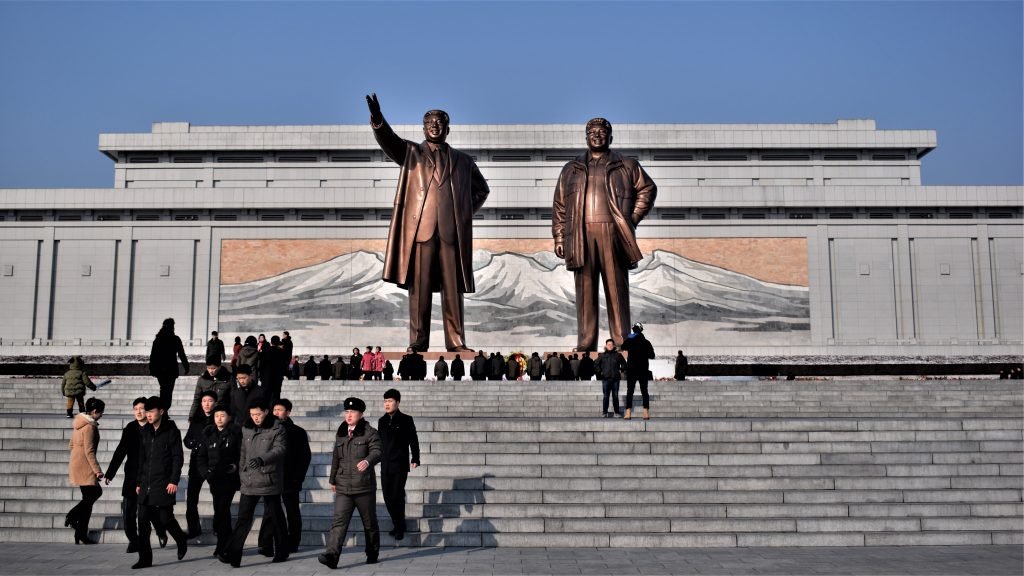
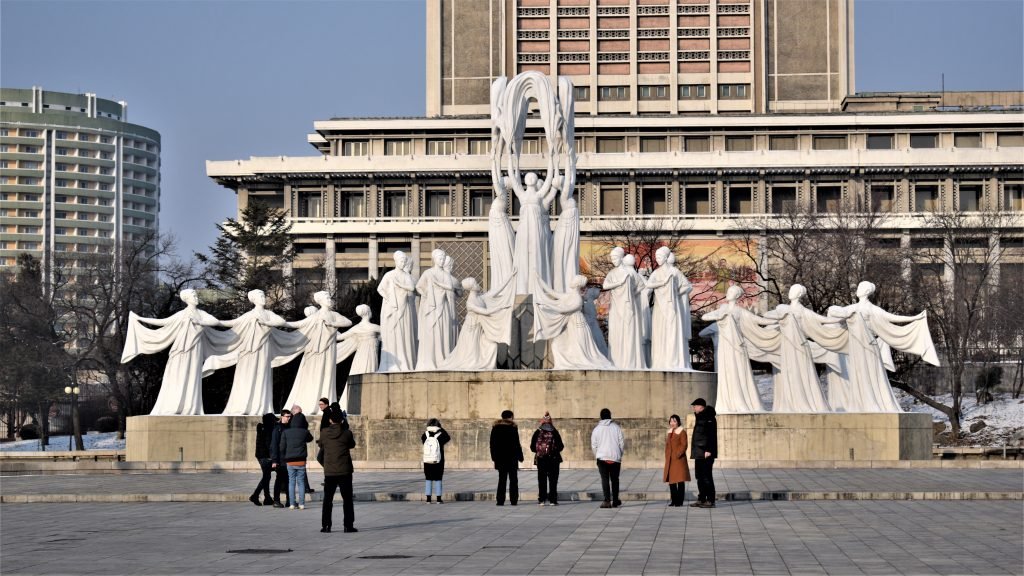
ARCH OF TRIUMPH
Modelled after the Arc de Triomphe in Paris, Pyongyang’s Arch of Triumph is a colossal structure in the centre of Pyongyang.
Built in 1982 to celebrate Kim Il-sung’s 70th birthday, using 25.550 granite blocks (one for each day of his life up until this point), it glorifies his role in the struggle for an independent Korea against the Japanese occupation.
Standing 60 metres tall, it exceeds its French counterpart by 10 metres, making it the second tallest triumphal arch in the world, right after Monumento de la Revolución in Mexico City.
Prominently positioned above revolutionary bronze reliefs are the years 1925 and 1945, presented in golden letters.
According to legend, in 1925 Kim Il-sung, at the tender age of 13, left North Korea for Manchuria to plan the liberation of his homeland. 1945 saw his triumphant return.
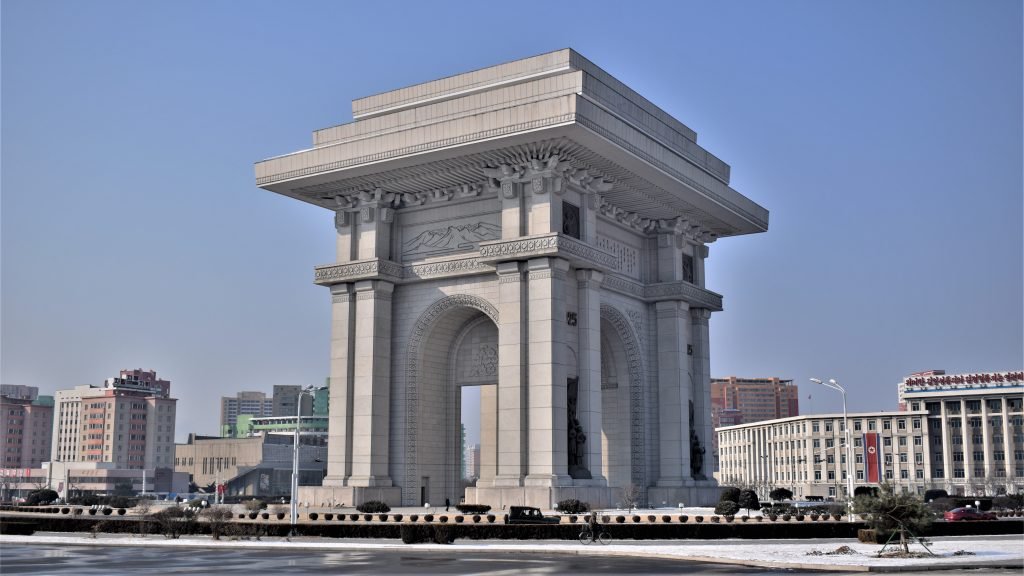
PYONGYANG METRO
For years, the Pyongyang metro has been the focal point of conspiracy theorists, claiming that the city doesn’t have a functioning subway system, and that the two stations accessible for tourists, were only constructed to impress foreign visitors.
However, since 2014 the whole metro is open for travellers, culminating in special Pyongyang metro tours, that will take you to every single station in the North Korean capital.
You’ll probably ask yourself, why anyone would travel to Pyongyang to ride the metro.
However, for those of you with an affinity for art, this trip might actually be worthwhile.
In the tradition of other communist and ex-soviet countries, the metro also functions as a public art gallery glorifying and celebrating the achievements of their ideology.
Colourful mosaics and brass reliefs lavishly decorate the ornate marble walls, while luxurious chandeliers adorn the white coloured ceiling, embellished with leaf and flower stucco.
In total, there are two lines consisting of 16 stations, each station named and designed after a certain theme of the North Korean revolution.
Visitors from Germany and especially Berlin will be surprised to find out that the train units actually have their origin in the German capital!
After being manufactured in West Germany between 1956 and 1965, the carriages were sold to North Korea in 1999 and are still in use today. If you look closely you can even spot the “Tags”, window scratchings typical for the German metropolis.
The stations also double as bomb shelters, some even reaching a depth of over 100 metres.
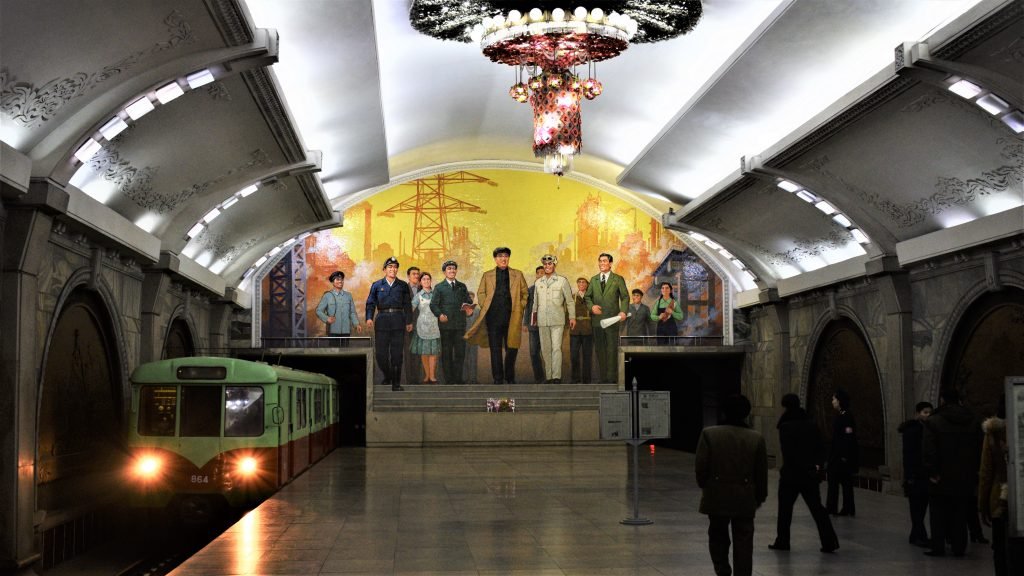
FLOWER EXHIBITION
On important occasions Pyongyang hosts a very unique exhibition (we visited on Kim Jong-il’s birthday).
During that time, the main exhibition hall is filled with art installations, either using a special kind of begonia called Kimjongilia (“Flower of Kim Jong-il”) or an orchid named Kimilsungia (“Flower of Kim Il-sung”).
The red begonia represents the Juche ideology and is supposed to bloom exactly on the 16th of February, Kim Jong-il’s birthday.
Miniature models of major North Korean landmarks, flags, fountains, and pictures of the past leaders complement the arrangements.
When I visited, the centre piece consisted of a stylized map showing an undivided Korea and a replica of Mount Paektu behind it.
Furthermore, this is one of the rare occasions you are allowed to roam freely (in the confines of the exhibition hall, of course) and mingle with the North Koreans, creating a very pleasant atmosphere.

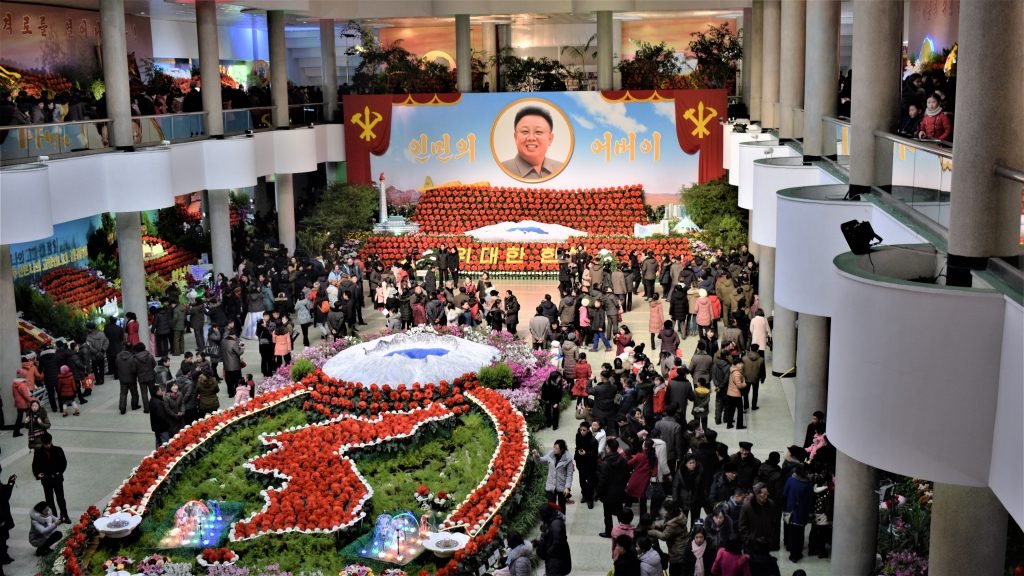
JUCHE TOWER
Rising to the heavens, the Juche Tower, truly is a beacon of North Korean identity.
Also erected for Kim Il-sung’s 70th birthday, it symbolizes Juche, an ideology developed by Kim Il-sung himself, leaning on Marxist-Leninist ideas, however, distinguishably Korean in its core.
Emphasizing self-reliance for all matters regarding the state, it is based on a set of principles, guiding North Korean policy since its invention. The belief is, that only through following those principles and striving for autarchy, a nation can achieve true socialism.
Just like the Arch of Triumph, the tower consists of 25.550 granite blocks. Topping the 150-metre spire is a 20-metre-tall metal torch, lit from the inside to give the impression of a burning fire.
I recommend taking the elevator to the top, rewarding you with spectacular views of the unfurling North Korean capital below.
You’ll be able to identify Kim Il-sung Square and the Great People’s Study Hall, the glistening, pyramid-shaped glass façade of the Ryugyong Hotel, as well as the biggest stadium in the world: Rungrado 1st of May Stadium, with a capacity of 114.000 people.
The entrance, completely covered in stone badges, is also worth a look. Each badge is a gift from foreign supporters of the Juche ideology , so you might be able to find one from your country, as well.
Three figures guard the Western side.
Standing proud on a pedestal, gazing at Pyongyang’s skyline, they hold up hammer, sickle, and calligraphy brush, representing the workers, farmers, and intellectuals of North Korea.
The symbolism presented here is remarkable.
Even though, the hammer, normally in the centre, is stretched to the side, the worker is marching in front, banishing the intellectual (and the female farmer), holding the brush, into the backrow, and enforcing his prominent standing in society.
This is a stunning compromise between an unchangeable party emblem (hammer and sickle) and the inclusion of the intelligentsia, forming the trinity of North Korean classes.
The representation granted to the intellectuals is unique for a communist country. The intelligentsia is normally seen as the enemy of the working class, hence its absence in the emblems of other socialist states.
It is not clear, why the DPRK chose to go a different route, however, by bringing the intellectuals in line with state leadership, instead of persecuting them, the Worker’s Party of Korea (WPK) strengthened their position in all classes of society.
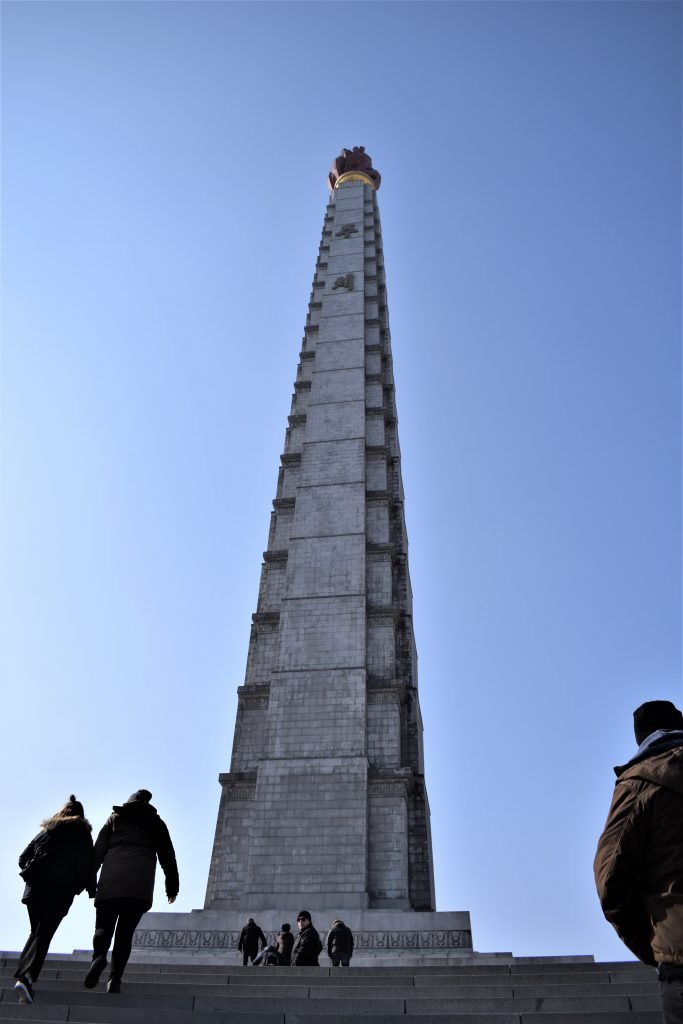

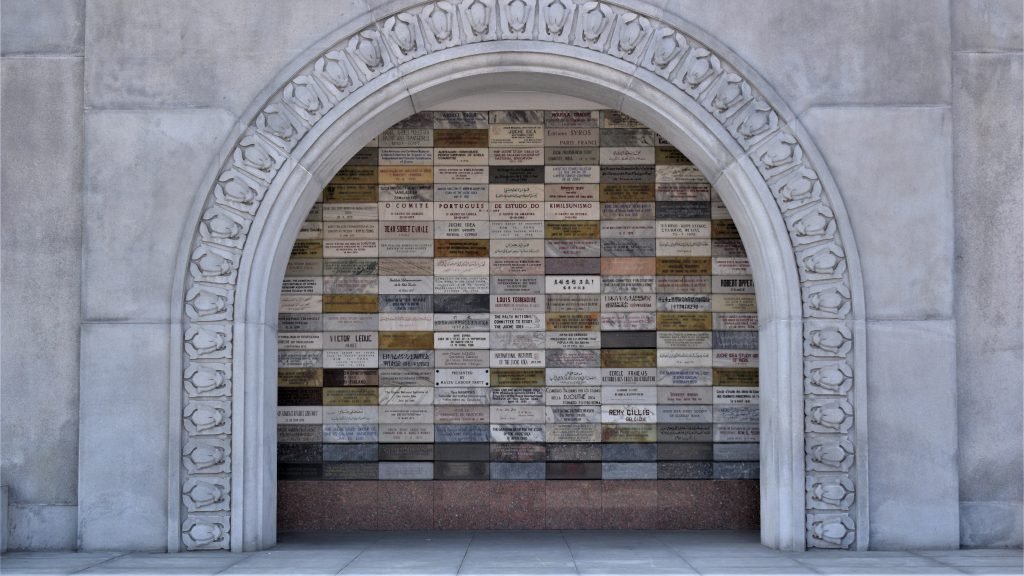
MONUMENT TO PARTY FOUNDING
The Monument to Party Founding is another iconic landmark in the North Korean capital.
Three giant stone hands, holding hammer, sickle, and calligraphy brush, reach for the skies.
The arms are surrounded by a belt. The inscription on the outside reads in golden letters: “Long live the Worker’s Party of Korea, leader and organizer of the victories of the people of Korea!”
Three bronze reliefs, representing the revolutionary roots of the party, the unity of the people under the party, and the party’s vision for a progressive future, decorate the inner side.
Behind the monument, two red stepped buildings with four Korean characters meaning “a hundred battles – a hundred victories”, the slogan of the Worker’s Party, complete the picture.
The yellowish apartment blocks around it, overlooking the withered grass, bestow a very bleak and dystopian look.


KWANGBOK DEPARTEMENT STORE
Not going to lie, it is strange to find a shopping centre on your travel itinerary.
In the context of North Korea, however, where malls like the Kwangbok Department Store are a novelty, it makes for an interesting socio-cultural experience.
The store consists of three floors and hosts a variety of shops. A Western style supermarket, shops for household appliances and a food court facilitate the growing middle class in Pyongyang to spend their newfound wealth on a variety of local and even Western products.
A fake IKEA store is located there as well, and although the Swedish furniture manufacturer is aware of that fact, it appears to be impossible to stop the illegal use of their brand.
Visiting the department store not only creates a wonderful opportunity to immerse yourself in the every-day life of Pyongyang’s citizens, while enjoying some traditional cuisine and a local beer, but is the only chance during your stint in the DPRK to exchange your money for the local currency North Korean Won (KPW).
Taking photos inside the Departement Store is prohibited.
OTHER SIGHTS
- Victorious War Museum: Probably my favourite sight in all of Pyongyang, this stunning complex shows the North Korean view on the Korean War. The pageantry and propaganda inside are a sight to behold. Lifesize replicas of KPA (Korean People’s Army) jungle camps and trenches, a 360-degree panorama of the Battle of Taejon and the captured US-Navy ship USS Pueblo are just a few of the exhibits displayed.
- Arch of Reunification: The Arch of Reunification spans the Reunification Highway leading out of Pyongyang. This impressive structure commemorates the efforts of Kim Il-sung towards a peaceful reunification after the Korean War. It consists of two women holding a sphere, showing an undivided Korea, in their hands.
- Rungrado 1st of May Stadium: This arena is not only the biggest stadium in the entire world, providing space for 114.000 people, but also the venue for the world-famous Arirang Mass Games. The festival is definitely on my bucket list, should I return to the DPRK!
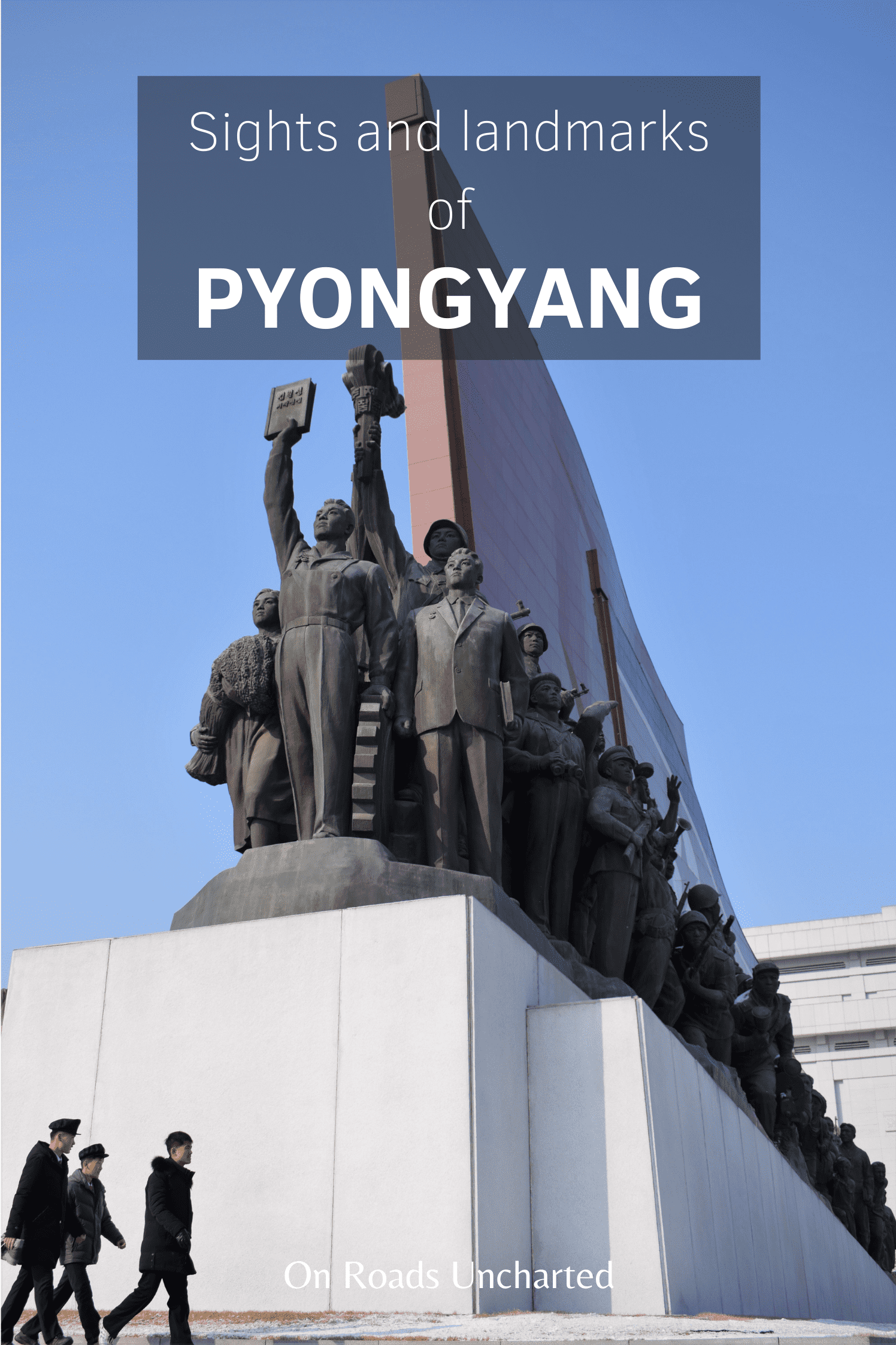
1 comment
Actually it isn’t a “mystery” why the intelligentsia are in-line with the ploretariat in the DPRK, because these groups both contribute to a self-reliant state. That’s why the metaphor of brains vs. brawn is always funny to me because the practical thing is brains + brawn. Focusing only on one and ignoring the other makes for an incomplete human and this extends to society. Also, communism just like capitalism come in different variations, so it’s weird to expect every communist government to be exactly the same.